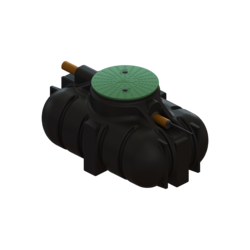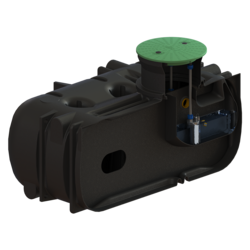Septic tanks
A septic tank is often the first stage of treatment for an individual sewer, i.e. a sewer for a property that is not connected to a communal sewer, and where the property owner is responsible for treating the household's wastewater before it is returned to the natural cycle.
A septic tank is an underground tank that separates and collects larger particles in the form of sludge so that subsequent treatment steps do not clog and can further purify the water.
With a wide range of septic tanks in different sizes, we can offer an optimal solution for every need. Each property's requirements are different and we have taken this into account by developing a range of flexible options.
- Low, compact design
- Recyclable
- Robust and durable
- Flexible
- High level of sludge separation/treatment
Read more +
All CPX septic tanks come with these benefits:
- Low design septic tanks.
This simplifies the transport of the bulky septic tank, and means that the septic tank does not have to be buried deeply, making the installation itself both faster and cheaper. Especially if there is a risk of running into rocks when digging, a low-build septic tank can make a big difference.
-Recyclable sept tanks.
All CPX septic tanks are made of ageing-resistant PE (Polyethylene) which is fully recyclable and allows circular use. In addition, there is no leakage from the material or from the septic tank during its lifetime, so in addition to the benefits of wastewater treatment, the soil in which the septic tank is placed is not affected.
-Robust and durable septic tanks.
Both the structure and the material have been developed without compromising on function and quality and are designed for Scandinavian conditions. The septic tanks are self-supporting, which means that they can even be used above ground, without being buried. This is only possible with tanks that are stable. Even the installation depth of up to 3m is a testament to just how robust the septic tanks are and that they will provide safe operation for a very long time.
-Flexible septic tanks.
Not only do we have septic tanks of different sizes, but we have adapted details and systems to achieve maximum flexibility. Installation depths of 0-3m allow coverage of most cases, regardless of whether there is a steep slope on the property or whether the property has a basement. Inlets and outlets can be varied between short side/long side to facilitate placement of the septic tank. The septic tanks are available with or without pump and pumping well to meet the requirements of your individual situation.
-High level of sludge separation/treatment
Threshold values for wastewater treatment do not represent our level of ambition, rather we have challenged ourselves and the industry to strive for the best possible treatment without adding cost or complexity. We offer a very high sludge separation capacity of down to 0.11 grams.
Septic tank or three-chamber tank?
The terms septic tank and three-chamber tank usually refer to the same thing, and the term three-chamber tank comes from the fact that it is a septic tank divided into three chambers to allow the water to flow slowly so that the sludge stays in the tank. Our most basic septic tank is a two-chamber, smaller-volume unit, which is usually quite sufficient for treating only household wastewater from bathroom, shower and laundry, so called grey water. However, a sewer that also integrates a toilet needs a slightly larger version in the form of a three-chamber septic tank.
How to choose a septic tank
When choosing a septic tank, you have to take into account conditions that are unique to each property. It is wise to assess the situation and, after consultation, make appropriate choices.
Type of wastewater
Wastewater from a property is divided into 2 types, black water and grey water, and the type of wastewater influences the choice of septic tank. The difference between the two is that black water includes toilet waste water, while grey water is only water from bath, shower and laundry.
Size of septic tank
A basic rule for choosing the right size of septic tank is that a household of up to 5 people needs a septic tank of just over 2000L for wastewater including all wastewater (black water) at normal protection level, while if you do not have a flush toilet connected but only grey water, you can manage with just over 1000L.
Our recommendation is that this should be considered as a minimum and that you should preferably choose as large a septic tank as you think you can afford. This is to avoid overloading at high usage and to create some margin for what you may need in the future. Sludge removal will have to be performed less frequently on a larger septic tank with a large sludge storage capacity, and if sludge removal is managed according to actual needs, you can rest assured that the investment in a larger tank will pay off in the long run, both for your wallet and the environment. Think ahead – it will pay off.
Placement of septic tank
We recommend that property owners seek advice on the most appropriate location of the septic tank on their property. Contractors or consultants offer valuable experience and will take into account, for example, sludge removal, proximity to water and the slope of the land.
Usage of septic tank
Avoid flushing rubbish and objects down the toilet that could get stuck in the sewer. Chemicals and large amounts of grease should not be poured down the drain as they may also interfere with the operation of the septic tank. Apart from these restrictions, which are universal, there is nothing special to consider regarding use. See also operation and maintenance!
Operation and maintenance of septic tanks
A septic tank must be emptied of sludge regularly by vacuum truck and all chambers must be inspected at that time. At the correct load, there should be only floating sludge in the first chamber and, if any, only small amounts of bottom sludge in chambers 2 or 3. CPX septic tanks have a large manhole which facilitates sludge removal and inspection of all chambers. At start-up or sludge removal, the septic tank must first be filled with water to provide proper treatment.
Safety of septic tanks
Our septic tanks come with a child-proof lid that cannot be opened without tools. The lid is designed so that it cannot be stepped through but is not passable by car or other heavier vehicle. Never enter a septic tank during operation!
How does a septic tank work?
CPX septic tanks are designed to provide an extra-long sedimentation distance where the wastewater moves slowly so that particles can be collected in the form of sludge. The first chamber of the septic tank where the wastewater enters from the property is also the largest, and in this chamber floating sludge forms, which sinks when the water is stationary and becomes bottom sludge. The following chambers are smaller in size, and water is transferred between the chambers at a carefully designed height to provide the best function for purification and sludge retention. In the last chamber there is an outlet and the possibility to place a pump if you do not have a gravity flow or want to control the amount that leaves for the subsequent infiltration, which can have advantages for this treatment stage.
Certification of septic tanks
It is a European requirement for septic tanks to be CE marked and thus verified, tested and documented according to EN12566: “Small wastewater treatment systems for up to 50 PT - Part 1: Prefabricated septic tanks”. All CPX septic tanks are CE marked in cooperation with RISE (formerly SP).





